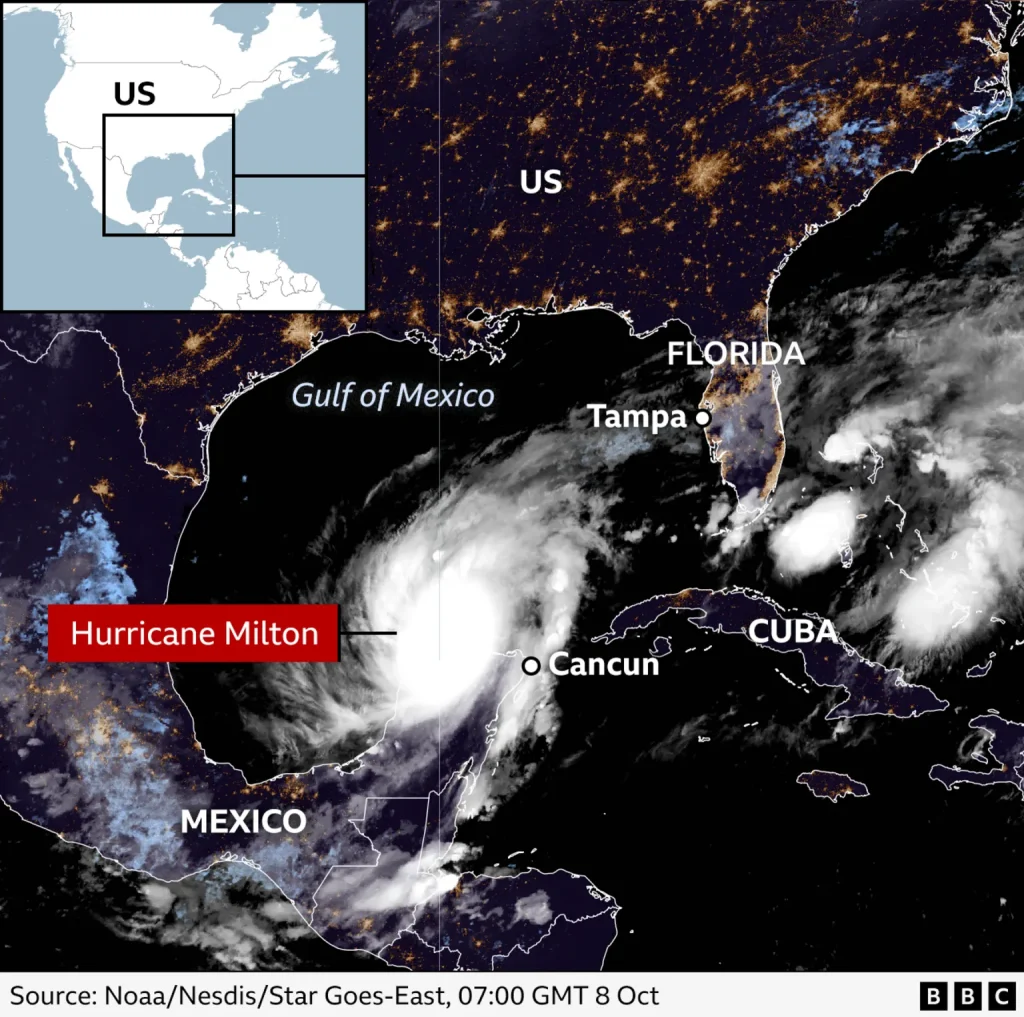The National Hurricane Center (NHC) expects Milton to hit Florida as a very dangerous hurricane on Wednesday night.
It may come close to the city of Tampa, which has over three million people living nearby.
Forecasters warn of heavy rain, flash flooding, strong winds, and rising water from the ocean.
They say Milton could be the worst storm in the area in about 100 years, with water levels rising 10 to 15 feet and local rain amounts reaching 1.5 feet.
Where is Hurricane Milton – and what is its path?
Milton became a category one hurricane on Sunday and has been moving east through the Gulf of Mexico after passing near Mexico’s Yucatan Peninsula.
It was rated as a category five hurricane, but later was lowered to category four.

Even though the hurricane weakened on Tuesday, officials warned it could get bigger before hitting Florida again on Wednesday.
The center of the hurricane is expected to go over west-central Florida on Wednesday, with a big surge of water expected along part of the coast.
It will then move across the state before going into the Atlantic Ocean.
What is a hurricane and how do they form?
Hurricanes, also called cyclones or typhoons, are strong tropical storms that happen in the North Atlantic. They bring strong winds and heavy rain.
Hurricanes form when warm, moist air over the ocean rises and cools, creating clouds.
If the air at the top of the hurricane moves away quickly, the air below can’t replace it fast enough, which lowers the pressure at the surface.
Lower pressure makes the winds get stronger, pulling in more air and making the hurricane stronger.
The National Oceanic and Atmospheric Administration (NOAA) expects the 2024 hurricane season to be busier than usual. They say rising ocean temperatures caused by climate change are partly to blame.
What is a category five hurricane?
Category five hurricanes are called “catastrophic” by NOAA.
They have wind speeds over 155 mph (249 km/h) and can cause very serious damage.
The US government says people should evacuate from areas near the coast because a category five hurricane can bring high waves over 18 feet (5 m) and destroy many homes.
Trees and power lines can fall, leaving neighborhoods cut off and without electricity for a long time. NOAA says some places can be unlivable for weeks or months.
**Worst US category fives:**
Since 1924, at least 40 storms in the Atlantic have been category five, but only four have hit land at that strength. Here are some of the worst:
**Hurricane Camille**
Camille hit Mississippi in 1969 with waves of 24 feet, destroying almost everything along the coast. It killed 259 people and caused about $1.4 billion in damage.
**Hurricane Andrew**
Andrew hit southern Florida in 1992 with winds up to 165 mph. It killed 26 people directly and caused $30 billion in damage, making it the costliest natural disaster in the US at that time.
**Hurricane Michael**
Michael struck Florida in 2018 with winds of 160 mph, making it the strongest storm to hit the state. It caused at least 74 deaths and about $25.1 billion in damage.
**Lower-category storms:**
Milton came less than two weeks after Hurricane Helene hit the US as a category four storm, killing over 200 people and becoming the deadliest hurricane since Hurricane Katrina in 2005.